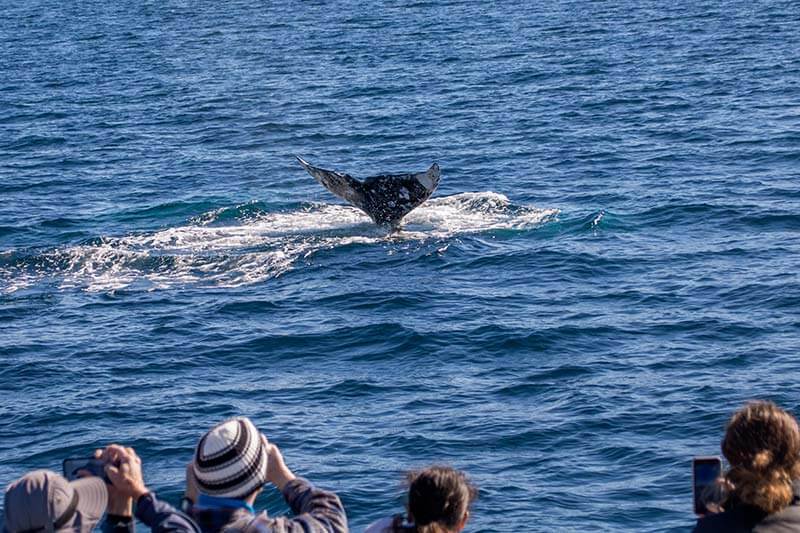What Weather is Best for Whale Watching?

Why should you book a whale watching trip in Dana Point? Over 275 days of sunshine each year earns Orange County the title for the best weather for whale watching. No matter what day you choose to go, it is likely you will be surrounded by sunshine and moderate whale watching weather. In our humble opinion, the best time to go whale watching is when you book your trip aboard Capt. Dave’s Dolphin and Whale Watching Safari®. Our fleet comprises multiple vessels with plenty of varied seating arrangements designed to accommodate any group size and built to handle any kind of weather.
But do whales still come out when it rains?
Since whales and dolphins are mammals and require air to breathe (just like us), the weather above the ocean’s surface doesn’t change the fact that they still need air and that they always have to come to the surface to breathe. The best weather for whale watching is whenever the animals are seen at the surface! Much to many passengers’ surprise, whale watching weather in South Orange County is truly any time of day, all day long – even when it rains! February is considered the wettest month in Orange County, however, February is also when we are lucky enough to see gray whales during multiple trips throughout the day!
The best weather for whale watching occurs all year long, with the opportunity to see multiple species. Whale watching is especially exciting during the winter months when gray whales migrate from Alaska to the lagoons of Mexico each year and then back again to their home in Alaska. Seeing a 39-52 foot barnacle-covered gray beauty up close and personal is truly a magical and life-changing site to see! Hugging our Southern California coastlines as they head down to the lagoons of Mexico is more than just an amazing sighting. Possibly catching a glimpse of these magnificent creatures, who once feared man, is a time to connect with these animals.
Experiencing firsthand why the best weather for whale watching in Southern California brings about the most immersive experiences in Dana Point is an experience worth having. Gray whales, who hold the title of the longest migrations of the entire baleen whale species, also hold the record for the longest mammalian migrations, period! Traveling between 5,000 to 7,000 miles on each leg of their journey, it’s no wonder they need all the rest they can get in the lagoons of Baja.
Regardless of the weather, the best weather for whale watching relies on where the food is. Whales and dolphins hunt for small schooling bait fish and tiny krill whenever and wherever they can find it. Rain or shine, we know you will love being part of an epic experience, interacting with the ocean life that graces our presence on one of our incredible journeys out to sea.
What are the best weather months for whale watching?
Different species visit our waters during different months throughout the year. As noted above, when autumn and winter months are upon us, we anxiously await the first sighting of gray whales or Eschrichtius robustus of the family Eschrichtiidae. Beginning as early as November, we see these gorgeous whales as they make their way past the Dana Point Headlands and yonder to Baja. When it’s time to begin the long journey back home to their feeding grounds in the Chukchi Sea, we are blessed to see these magical creatures as they head north, sometimes with their little ones in tow.
Just as the bare limbs on the trees lining the shore begin to show new beginnings of life, the later spring months leading well into early summer is another opportunity to enjoy warmer days on the ocean. Spring and summer seasons provide some of the best weather for whale watching and bring about the presence of the magnificent and giant blue whales, or Balaenoptera musculus, off the Southern California coast just outside of our very own Dana Point Harbor. What makes this timeframe and season such great whale watching weather are the longer days, giving us more time out on the water to book multiple trips for passengers to see whales.
The best weather for whale watching is right here in Dana Point, the Dolphin and Whale Watching Capital of the World®. Whale watching weather goes from great to outstanding when you see a blue whale extending their impressive body over 85 feet long, dwarfing all of our vessels, reminding all of us about the impactful sight these animals can have on our lives. Having the reputation of being the largest whale is one thing, but having the accolades of being the largest animal to have EVER roamed planet Earth is certainly worth showing off!
Every year we are thrilled to see their reappearance and share our knowledge and love of these precious creatures with passengers and repeat passengers alike, all while enjoying the best weather for whale watching. Sighting a blue whale is magnificent and something most people on Earth will never get to do. Only 1% of all people on Earth will ever see a blue whale – so join us today! No matter how many times you are lucky enough to capture a glimpse of these awe-striking beauties, you will be reminded that the best whale watching weather in Southern California, is a day when blue whales could be on your sightseeing list!
So…Why does Dana Point have such great whale watching?
Phenomenal whale watching weather is one reason passengers love to see whales with Capt. Dave’s Dolphin and Whale Watching Safari, but the underwater topography here also plays a huge role in having the best whale watching weather. Mountainous peaks and deep ocean trenches line the ocean seafloor in Dana Point, CA, Whale Watching Capital Of The World, making this area the best whale watching in Orange County. An oceanographic phenomenon called upwelling keeps our Dana Point ocean waters stocked with an abundance of sought-after food by various species of both baleen and toothed whales alike. An abundant food source for cetaceans is one of the key aspects of why whale watching weather means watching whales all year round in Dana Point.
Upwelling occurs when offshore winds mixed with the current bring the colder, dark, nutrient-rich water deep down below to the surface. Thus, upwelling creates the perfect environment by fertilizing seaweeds and phytoplankton to come to the surface. The upwelling process creates the world’s most fertile ecosystems, allowing algae to grow and support the coastal food web. So what are you waiting for? Book a trip today to one of the best whale watching locations in the world that also owns the top spot for the best weather for whale watching too!
In just minutes aboard one of our whale watching safaris, the ocean depth fluctuates from approximately 20 feet at Capt. Dave’s docks to nearly 3,000 feet in the open ocean. This huge range of depth begins at the entrance to the harbor and as you cross the peaks and valleys, creates what we call “the dropoff”, a favorite spot amongst the many whale species we see all year long. Larger baleen whales, offshore bottlenose dolphins, and Risso’s dolphins, known as Grampus griseus also tend to frequent the dropoff zones too. Toothed whales like dolphins and larger baleen whales know the best weather for whale watching is right around the corner waiting for you to book your trip!
Dana Point whale watching is rich in marine life. From pinnipeds to whales, dolphins, sharks, and turtles, there is so much to see out on the water on your upcoming Safari tour. No matter what boat you choose for your trip, our expert captains and crew are dedicated to ensuring you have a great experience and create lasting memories and connections with the sea and its inhabitants. Rain or shine, we are sure that you are going to have a great time out at sea with us!
Until Next Time,
Jess Wright
First Mate & Marine Naturalist
